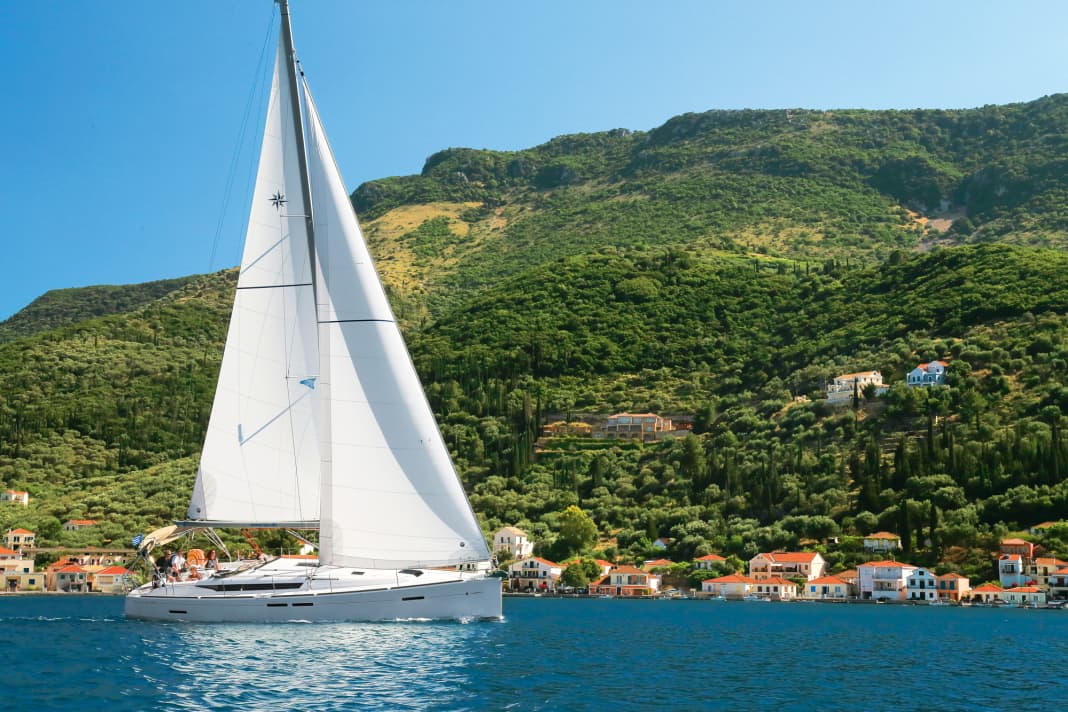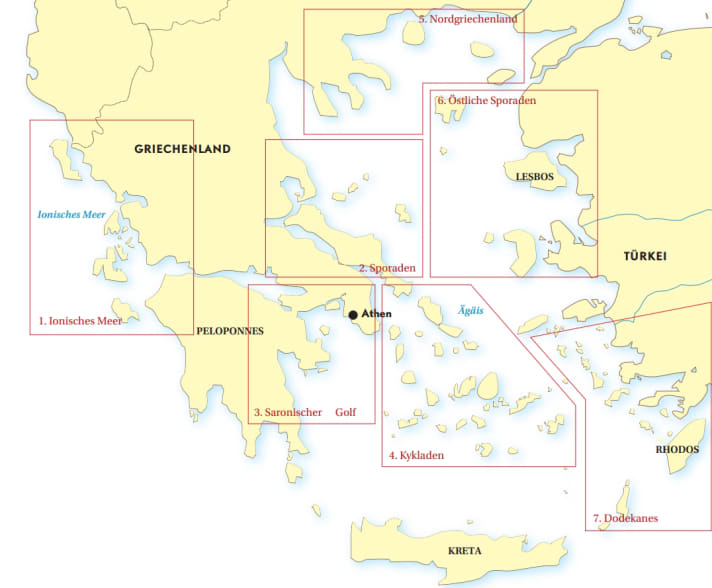





Over 3,000 islands, but only around 100 of them inhabited: the Greek waters are a vast area that hardly requires a lifetime of sailing to see everything. The big question, especially for beginners, is: which one is right for me? The rather green, light-winded Ionian Sea? Or the barren, windswept Cyclades with their white cube houses? And what distinguishes the Dodecanese islands, which are quite close to each other, from the Cyclades? Our following area guide provides orientation on the different levels of difficulty, infrastructure and character of the islands. If you want to beat the Meltemi, you can also book one-way trips from Athens to Kos, Mykonos or Rhodes, but the surcharges are often steep, starting at around 600 euros.

1. the Ionian Sea
The classic sailing area for beginners or crews who don't want to sail in the windier Aegean. Above all, there are two starting harbours that are easy to reach with direct flights: Corfu in the north and Lefkas/Palairos (Preveza airport) in the centre. The start in Corfu makes the longer journey to and from Lefkas (approx. 30 miles) necessary at the beginning and end. The islands are very green and mountainous, and the smaller islets are perfectly protected by the lee of Lefkas, Kefalonia and Ithaca. The distances there are short. In summer, however, it is the most crowded area in Greece. The charter offer is huge. About half start from Corfu, the others from the centre. If you are only sailing for a week, you have more destinations from Lefkas. Zakynthos in the south offers few destinations and means long journeys, and is only recommended as part of a 14-day cruise. Often calm at night, the area is rather thermally dominated in summer. Lots of southerly winds and thunderstorms in spring and autumn.
2. sporades
Small-scale island area in the north, where the Meltemi is somewhat weaker. You start in the Gulf of Volos and sail around the three pretty main islands of Skiathos, Skopelos and Alonnisos, including the smaller neighbouring islands. Perhaps also plan a detour to Euboea. The choice of route is somewhat less flexible than in the larger Aegean regions. As everything is so manageable, you can easily spend a week sailing here, but two weeks won't be boring either. The flight connections to Volos were difficult, as there were very few direct flights from Germany.
3. the Saronic and Argolic Gulfs
The area a little south-west of Athens is popular for a short week's cruise. With Aegina, Poros, Hydra, Dokos and several mainland harbours, it is a beautiful holiday destination, but is somewhat overcrowded in summer, especially at weekends. The harbours are bursting at the seams, especially Hydra (photo), which is notorious for anchor chaos, but is also beautiful. Short distances, and from Hydra onwards the coast offers some protection from Meltemi. A beginner's alternative to the Ionian Sea for less experienced crews, but not in July and August. If you want to sail longer, you can simply extend the area to include the Argolic Gulf and the east coast of the Peloponnese, where there are places worth seeing.
4th Cyclades
The royal territory of the Aegean. The strongest Meltemi winds blow here and the distances between the islands are long. But there is plenty of variety. Some cult islands are worth the trip, such as Santorini or Mykonos. The characters of the islands are so different that there is always something new to discover. The Cyclades are windswept, bare and offer the typical panorama of white cube houses on steep slopes. There are plenty of good anchorages, but almost only relatively simple municipal harbours. At Meltemi, the moorings with bow anchors are sometimes challenging and are often sailed reefed. Something for experienced crews who are not afraid of strong winds. But: it is often weathered in shorts and a T-shirt, the sea is a deep blue colour, as is the sky. If you want to approach the area carefully, come in the early or late season, i.e. from May to early June or late September to mid-October. The starting harbours are Athens or Lavrion, which is better for a week.
5. northern Greece
The area to the south of Thessaloniki around the three fingers of the Halkidiki peninsula is a developing sailing area. There are a few charter bases and it is less crowded, the Meltemi is much weaker. But the distances between the destinations are long. The area is famous for the monastic mountain republic of Athos, which can only be visited with a pilgrim's permit.
6. eastern Sporades
The area around Samos and Lesbos has fallen somewhat by the wayside in recent years as a result of the influx of refugees there and the inadvisable change of border to Turkey. There are few charter bases and just as few smaller islands. Something for connoisseurs of Greece who are looking for something new.
7th Dodecanese
The ideal alternative to the Cyclades if you want to avoid the long hauls. The distances between the islands, which are also rather barren, are shorter, so there is always more shelter. On top of that, there are three good marinas here: Kos, Leros and the new one in Rhodes (not the city harbour). The Meltemi is also strong in summer. Good journey with direct flights to Kos or Rhodes. It is ideal to explore the northern islands from Kos against the Meltemi. Kalymnos, Leros, Lipsi and Patmos have enchanted every visitor. There are very sheltered bays, some buoy fields in front of tavernas and good harbours. At the end, return with the wind or sail even further towards the southern islands. This requires 14 days. Or you can start a week northwards from Rhodes.

